Design of a Water Supply System for Mudgee, NSW, Australia
VerifiedAdded on 2023/06/04
|27
|4879
|385
Project
AI Summary
This project report details the design of a water supply system for Mudgee, Australia, addressing the town's growing population and the establishment of a new university. The design incorporates both groundwater and rainwater harvesting to ensure a sustainable and reliable water source capable of meeting the projected demands until 2070. The report includes an analysis of the local geographical conditions, including the potential of the Bowral aquifer, and evaluates alternative water sources. It covers pump selection and design, storage tank design, and the layout of the distribution network. The methodology involves population growth forecasting, water demand calculations, and a bill of quantities with cost estimations. The report also addresses water quality testing and presents findings and discussions on the proposed system. The project aims to provide clean, safe, and adequate water for the residents, students, and staff of Mudgee, offering a comprehensive solution to the town's water supply challenges.
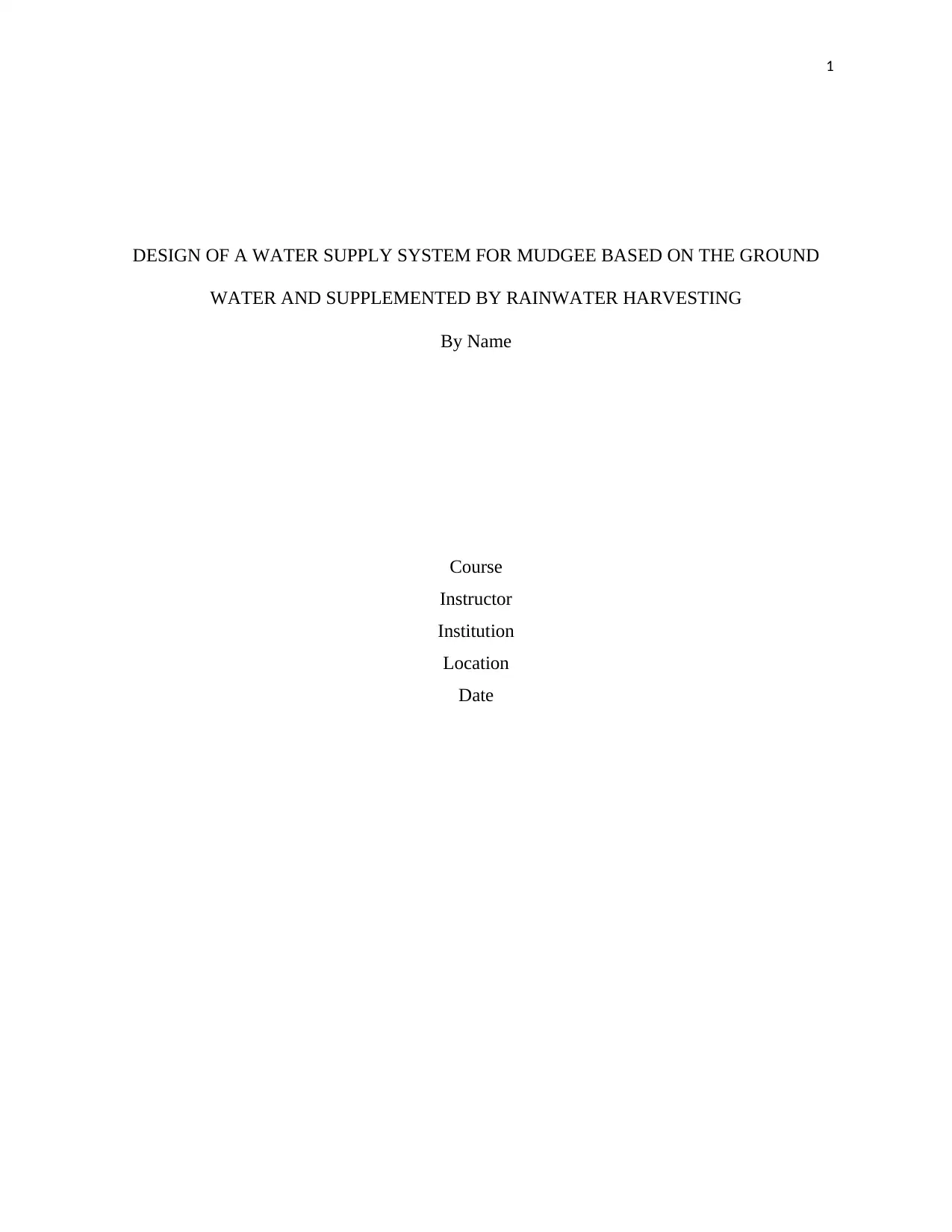
1
DESIGN OF A WATER SUPPLY SYSTEM FOR MUDGEE BASED ON THE GROUND
WATER AND SUPPLEMENTED BY RAINWATER HARVESTING
By Name
Course
Instructor
Institution
Location
Date
DESIGN OF A WATER SUPPLY SYSTEM FOR MUDGEE BASED ON THE GROUND
WATER AND SUPPLEMENTED BY RAINWATER HARVESTING
By Name
Course
Instructor
Institution
Location
Date
Paraphrase This Document
Need a fresh take? Get an instant paraphrase of this document with our AI Paraphraser
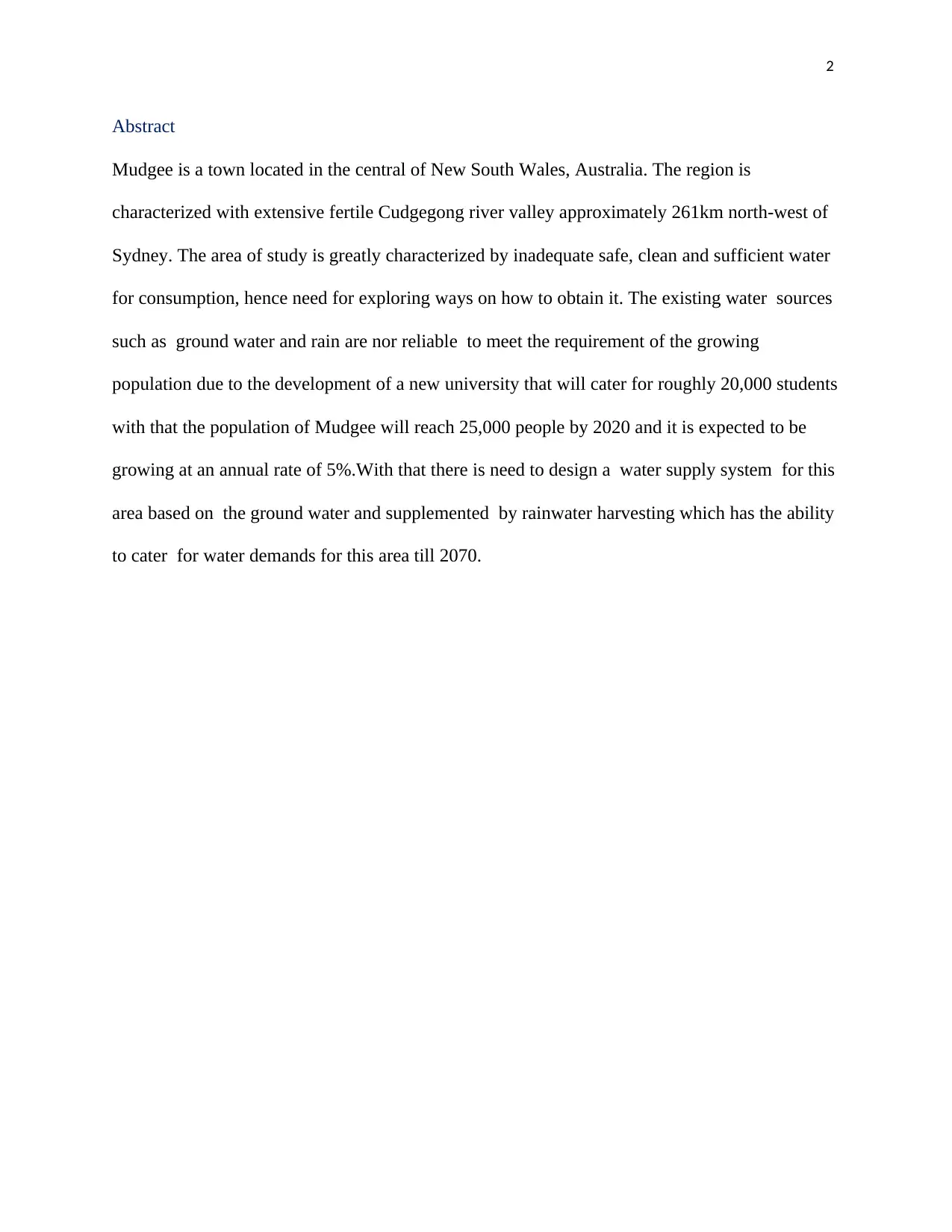
2
Abstract
Mudgee is a town located in the central of New South Wales, Australia. The region is
characterized with extensive fertile Cudgegong river valley approximately 261km north-west of
Sydney. The area of study is greatly characterized by inadequate safe, clean and sufficient water
for consumption, hence need for exploring ways on how to obtain it. The existing water sources
such as ground water and rain are nor reliable to meet the requirement of the growing
population due to the development of a new university that will cater for roughly 20,000 students
with that the population of Mudgee will reach 25,000 people by 2020 and it is expected to be
growing at an annual rate of 5%.With that there is need to design a water supply system for this
area based on the ground water and supplemented by rainwater harvesting which has the ability
to cater for water demands for this area till 2070.
Abstract
Mudgee is a town located in the central of New South Wales, Australia. The region is
characterized with extensive fertile Cudgegong river valley approximately 261km north-west of
Sydney. The area of study is greatly characterized by inadequate safe, clean and sufficient water
for consumption, hence need for exploring ways on how to obtain it. The existing water sources
such as ground water and rain are nor reliable to meet the requirement of the growing
population due to the development of a new university that will cater for roughly 20,000 students
with that the population of Mudgee will reach 25,000 people by 2020 and it is expected to be
growing at an annual rate of 5%.With that there is need to design a water supply system for this
area based on the ground water and supplemented by rainwater harvesting which has the ability
to cater for water demands for this area till 2070.
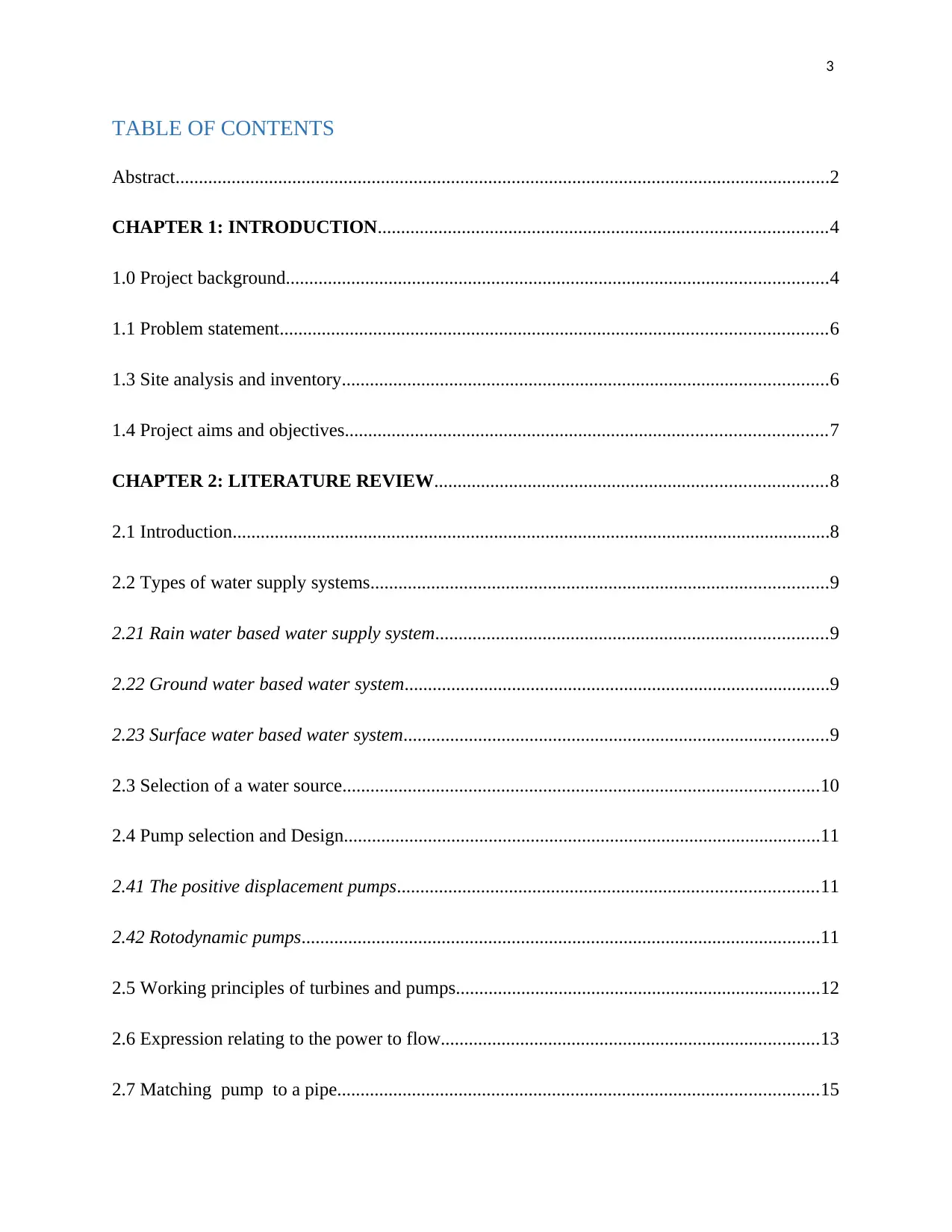
3
TABLE OF CONTENTS
Abstract............................................................................................................................................2
CHAPTER 1: INTRODUCTION................................................................................................4
1.0 Project background....................................................................................................................4
1.1 Problem statement.....................................................................................................................6
1.3 Site analysis and inventory........................................................................................................6
1.4 Project aims and objectives.......................................................................................................7
CHAPTER 2: LITERATURE REVIEW....................................................................................8
2.1 Introduction................................................................................................................................8
2.2 Types of water supply systems..................................................................................................9
2.21 Rain water based water supply system....................................................................................9
2.22 Ground water based water system...........................................................................................9
2.23 Surface water based water system...........................................................................................9
2.3 Selection of a water source......................................................................................................10
2.4 Pump selection and Design......................................................................................................11
2.41 The positive displacement pumps..........................................................................................11
2.42 Rotodynamic pumps...............................................................................................................11
2.5 Working principles of turbines and pumps..............................................................................12
2.6 Expression relating to the power to flow.................................................................................13
2.7 Matching pump to a pipe.......................................................................................................15
TABLE OF CONTENTS
Abstract............................................................................................................................................2
CHAPTER 1: INTRODUCTION................................................................................................4
1.0 Project background....................................................................................................................4
1.1 Problem statement.....................................................................................................................6
1.3 Site analysis and inventory........................................................................................................6
1.4 Project aims and objectives.......................................................................................................7
CHAPTER 2: LITERATURE REVIEW....................................................................................8
2.1 Introduction................................................................................................................................8
2.2 Types of water supply systems..................................................................................................9
2.21 Rain water based water supply system....................................................................................9
2.22 Ground water based water system...........................................................................................9
2.23 Surface water based water system...........................................................................................9
2.3 Selection of a water source......................................................................................................10
2.4 Pump selection and Design......................................................................................................11
2.41 The positive displacement pumps..........................................................................................11
2.42 Rotodynamic pumps...............................................................................................................11
2.5 Working principles of turbines and pumps..............................................................................12
2.6 Expression relating to the power to flow.................................................................................13
2.7 Matching pump to a pipe.......................................................................................................15
⊘ This is a preview!⊘
Do you want full access?
Subscribe today to unlock all pages.

Trusted by 1+ million students worldwide
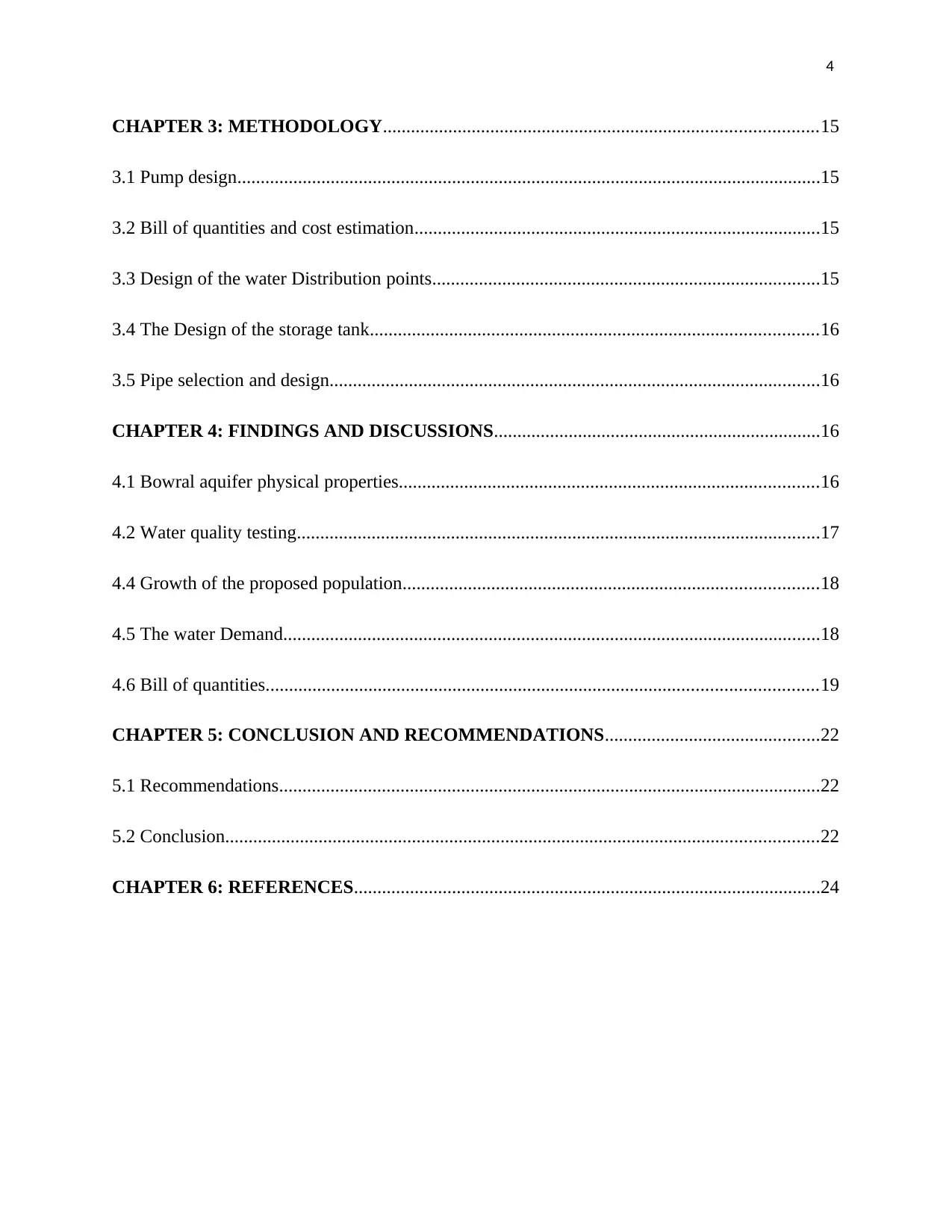
4
CHAPTER 3: METHODOLOGY.............................................................................................15
3.1 Pump design.............................................................................................................................15
3.2 Bill of quantities and cost estimation.......................................................................................15
3.3 Design of the water Distribution points...................................................................................15
3.4 The Design of the storage tank................................................................................................16
3.5 Pipe selection and design.........................................................................................................16
CHAPTER 4: FINDINGS AND DISCUSSIONS......................................................................16
4.1 Bowral aquifer physical properties..........................................................................................16
4.2 Water quality testing................................................................................................................17
4.4 Growth of the proposed population.........................................................................................18
4.5 The water Demand...................................................................................................................18
4.6 Bill of quantities......................................................................................................................19
CHAPTER 5: CONCLUSION AND RECOMMENDATIONS..............................................22
5.1 Recommendations....................................................................................................................22
5.2 Conclusion...............................................................................................................................22
CHAPTER 6: REFERENCES....................................................................................................24
CHAPTER 3: METHODOLOGY.............................................................................................15
3.1 Pump design.............................................................................................................................15
3.2 Bill of quantities and cost estimation.......................................................................................15
3.3 Design of the water Distribution points...................................................................................15
3.4 The Design of the storage tank................................................................................................16
3.5 Pipe selection and design.........................................................................................................16
CHAPTER 4: FINDINGS AND DISCUSSIONS......................................................................16
4.1 Bowral aquifer physical properties..........................................................................................16
4.2 Water quality testing................................................................................................................17
4.4 Growth of the proposed population.........................................................................................18
4.5 The water Demand...................................................................................................................18
4.6 Bill of quantities......................................................................................................................19
CHAPTER 5: CONCLUSION AND RECOMMENDATIONS..............................................22
5.1 Recommendations....................................................................................................................22
5.2 Conclusion...............................................................................................................................22
CHAPTER 6: REFERENCES....................................................................................................24
Paraphrase This Document
Need a fresh take? Get an instant paraphrase of this document with our AI Paraphraser
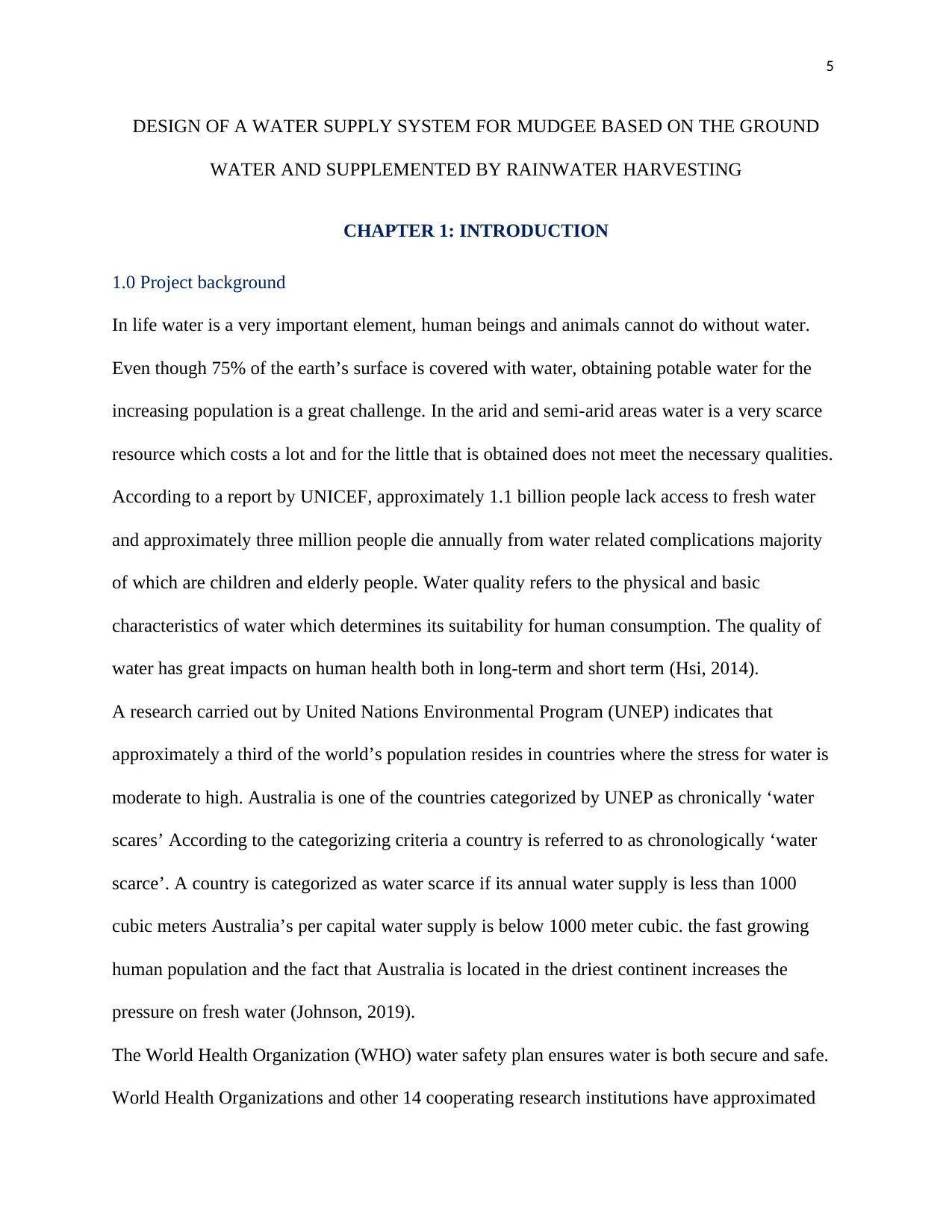
5
DESIGN OF A WATER SUPPLY SYSTEM FOR MUDGEE BASED ON THE GROUND
WATER AND SUPPLEMENTED BY RAINWATER HARVESTING
CHAPTER 1: INTRODUCTION
1.0 Project background
In life water is a very important element, human beings and animals cannot do without water.
Even though 75% of the earth’s surface is covered with water, obtaining potable water for the
increasing population is a great challenge. In the arid and semi-arid areas water is a very scarce
resource which costs a lot and for the little that is obtained does not meet the necessary qualities.
According to a report by UNICEF, approximately 1.1 billion people lack access to fresh water
and approximately three million people die annually from water related complications majority
of which are children and elderly people. Water quality refers to the physical and basic
characteristics of water which determines its suitability for human consumption. The quality of
water has great impacts on human health both in long-term and short term (Hsi, 2014).
A research carried out by United Nations Environmental Program (UNEP) indicates that
approximately a third of the world’s population resides in countries where the stress for water is
moderate to high. Australia is one of the countries categorized by UNEP as chronically ‘water
scares’ According to the categorizing criteria a country is referred to as chronologically ‘water
scarce’. A country is categorized as water scarce if its annual water supply is less than 1000
cubic meters Australia’s per capital water supply is below 1000 meter cubic. the fast growing
human population and the fact that Australia is located in the driest continent increases the
pressure on fresh water (Johnson, 2019).
The World Health Organization (WHO) water safety plan ensures water is both secure and safe.
World Health Organizations and other 14 cooperating research institutions have approximated
DESIGN OF A WATER SUPPLY SYSTEM FOR MUDGEE BASED ON THE GROUND
WATER AND SUPPLEMENTED BY RAINWATER HARVESTING
CHAPTER 1: INTRODUCTION
1.0 Project background
In life water is a very important element, human beings and animals cannot do without water.
Even though 75% of the earth’s surface is covered with water, obtaining potable water for the
increasing population is a great challenge. In the arid and semi-arid areas water is a very scarce
resource which costs a lot and for the little that is obtained does not meet the necessary qualities.
According to a report by UNICEF, approximately 1.1 billion people lack access to fresh water
and approximately three million people die annually from water related complications majority
of which are children and elderly people. Water quality refers to the physical and basic
characteristics of water which determines its suitability for human consumption. The quality of
water has great impacts on human health both in long-term and short term (Hsi, 2014).
A research carried out by United Nations Environmental Program (UNEP) indicates that
approximately a third of the world’s population resides in countries where the stress for water is
moderate to high. Australia is one of the countries categorized by UNEP as chronically ‘water
scares’ According to the categorizing criteria a country is referred to as chronologically ‘water
scarce’. A country is categorized as water scarce if its annual water supply is less than 1000
cubic meters Australia’s per capital water supply is below 1000 meter cubic. the fast growing
human population and the fact that Australia is located in the driest continent increases the
pressure on fresh water (Johnson, 2019).
The World Health Organization (WHO) water safety plan ensures water is both secure and safe.
World Health Organizations and other 14 cooperating research institutions have approximated
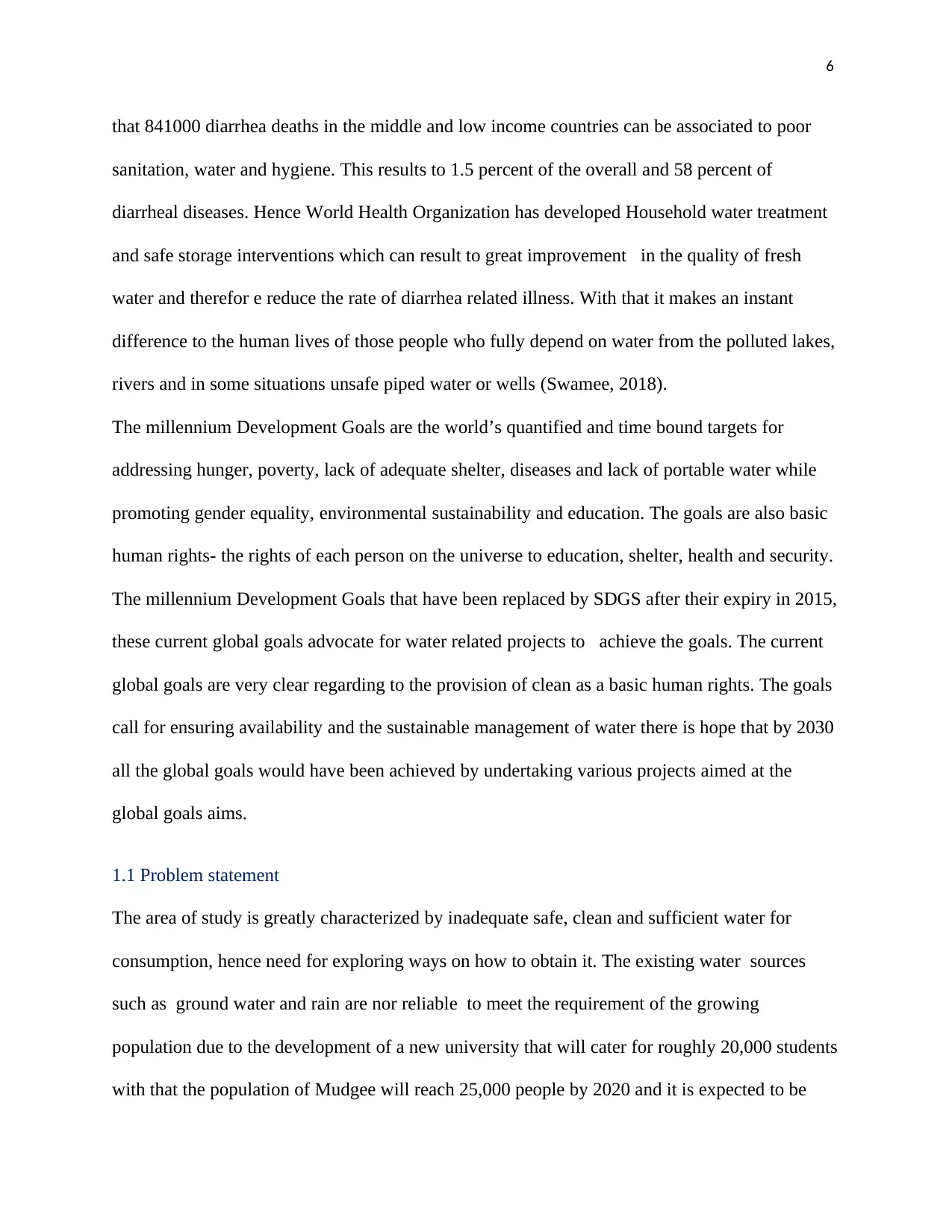
6
that 841000 diarrhea deaths in the middle and low income countries can be associated to poor
sanitation, water and hygiene. This results to 1.5 percent of the overall and 58 percent of
diarrheal diseases. Hence World Health Organization has developed Household water treatment
and safe storage interventions which can result to great improvement in the quality of fresh
water and therefor e reduce the rate of diarrhea related illness. With that it makes an instant
difference to the human lives of those people who fully depend on water from the polluted lakes,
rivers and in some situations unsafe piped water or wells (Swamee, 2018).
The millennium Development Goals are the world’s quantified and time bound targets for
addressing hunger, poverty, lack of adequate shelter, diseases and lack of portable water while
promoting gender equality, environmental sustainability and education. The goals are also basic
human rights- the rights of each person on the universe to education, shelter, health and security.
The millennium Development Goals that have been replaced by SDGS after their expiry in 2015,
these current global goals advocate for water related projects to achieve the goals. The current
global goals are very clear regarding to the provision of clean as a basic human rights. The goals
call for ensuring availability and the sustainable management of water there is hope that by 2030
all the global goals would have been achieved by undertaking various projects aimed at the
global goals aims.
1.1 Problem statement
The area of study is greatly characterized by inadequate safe, clean and sufficient water for
consumption, hence need for exploring ways on how to obtain it. The existing water sources
such as ground water and rain are nor reliable to meet the requirement of the growing
population due to the development of a new university that will cater for roughly 20,000 students
with that the population of Mudgee will reach 25,000 people by 2020 and it is expected to be
that 841000 diarrhea deaths in the middle and low income countries can be associated to poor
sanitation, water and hygiene. This results to 1.5 percent of the overall and 58 percent of
diarrheal diseases. Hence World Health Organization has developed Household water treatment
and safe storage interventions which can result to great improvement in the quality of fresh
water and therefor e reduce the rate of diarrhea related illness. With that it makes an instant
difference to the human lives of those people who fully depend on water from the polluted lakes,
rivers and in some situations unsafe piped water or wells (Swamee, 2018).
The millennium Development Goals are the world’s quantified and time bound targets for
addressing hunger, poverty, lack of adequate shelter, diseases and lack of portable water while
promoting gender equality, environmental sustainability and education. The goals are also basic
human rights- the rights of each person on the universe to education, shelter, health and security.
The millennium Development Goals that have been replaced by SDGS after their expiry in 2015,
these current global goals advocate for water related projects to achieve the goals. The current
global goals are very clear regarding to the provision of clean as a basic human rights. The goals
call for ensuring availability and the sustainable management of water there is hope that by 2030
all the global goals would have been achieved by undertaking various projects aimed at the
global goals aims.
1.1 Problem statement
The area of study is greatly characterized by inadequate safe, clean and sufficient water for
consumption, hence need for exploring ways on how to obtain it. The existing water sources
such as ground water and rain are nor reliable to meet the requirement of the growing
population due to the development of a new university that will cater for roughly 20,000 students
with that the population of Mudgee will reach 25,000 people by 2020 and it is expected to be
⊘ This is a preview!⊘
Do you want full access?
Subscribe today to unlock all pages.

Trusted by 1+ million students worldwide
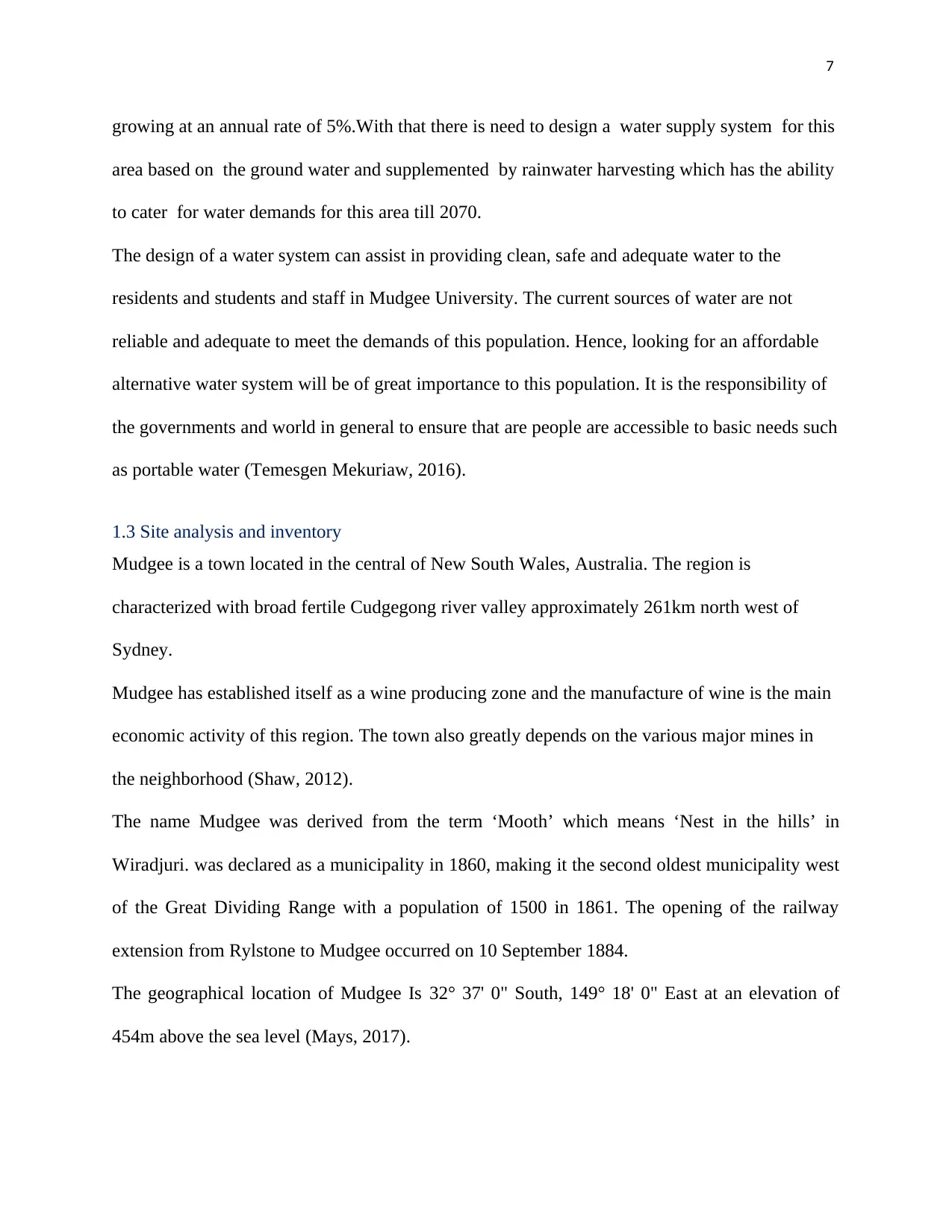
7
growing at an annual rate of 5%.With that there is need to design a water supply system for this
area based on the ground water and supplemented by rainwater harvesting which has the ability
to cater for water demands for this area till 2070.
The design of a water system can assist in providing clean, safe and adequate water to the
residents and students and staff in Mudgee University. The current sources of water are not
reliable and adequate to meet the demands of this population. Hence, looking for an affordable
alternative water system will be of great importance to this population. It is the responsibility of
the governments and world in general to ensure that are people are accessible to basic needs such
as portable water (Temesgen Mekuriaw, 2016).
1.3 Site analysis and inventory
Mudgee is a town located in the central of New South Wales, Australia. The region is
characterized with broad fertile Cudgegong river valley approximately 261km north west of
Sydney.
Mudgee has established itself as a wine producing zone and the manufacture of wine is the main
economic activity of this region. The town also greatly depends on the various major mines in
the neighborhood (Shaw, 2012).
The name Mudgee was derived from the term ‘Mooth’ which means ‘Nest in the hills’ in
Wiradjuri. was declared as a municipality in 1860, making it the second oldest municipality west
of the Great Dividing Range with a population of 1500 in 1861. The opening of the railway
extension from Rylstone to Mudgee occurred on 10 September 1884.
The geographical location of Mudgee Is 32° 37' 0" South, 149° 18' 0" East at an elevation of
454m above the sea level (Mays, 2017).
growing at an annual rate of 5%.With that there is need to design a water supply system for this
area based on the ground water and supplemented by rainwater harvesting which has the ability
to cater for water demands for this area till 2070.
The design of a water system can assist in providing clean, safe and adequate water to the
residents and students and staff in Mudgee University. The current sources of water are not
reliable and adequate to meet the demands of this population. Hence, looking for an affordable
alternative water system will be of great importance to this population. It is the responsibility of
the governments and world in general to ensure that are people are accessible to basic needs such
as portable water (Temesgen Mekuriaw, 2016).
1.3 Site analysis and inventory
Mudgee is a town located in the central of New South Wales, Australia. The region is
characterized with broad fertile Cudgegong river valley approximately 261km north west of
Sydney.
Mudgee has established itself as a wine producing zone and the manufacture of wine is the main
economic activity of this region. The town also greatly depends on the various major mines in
the neighborhood (Shaw, 2012).
The name Mudgee was derived from the term ‘Mooth’ which means ‘Nest in the hills’ in
Wiradjuri. was declared as a municipality in 1860, making it the second oldest municipality west
of the Great Dividing Range with a population of 1500 in 1861. The opening of the railway
extension from Rylstone to Mudgee occurred on 10 September 1884.
The geographical location of Mudgee Is 32° 37' 0" South, 149° 18' 0" East at an elevation of
454m above the sea level (Mays, 2017).
Paraphrase This Document
Need a fresh take? Get an instant paraphrase of this document with our AI Paraphraser
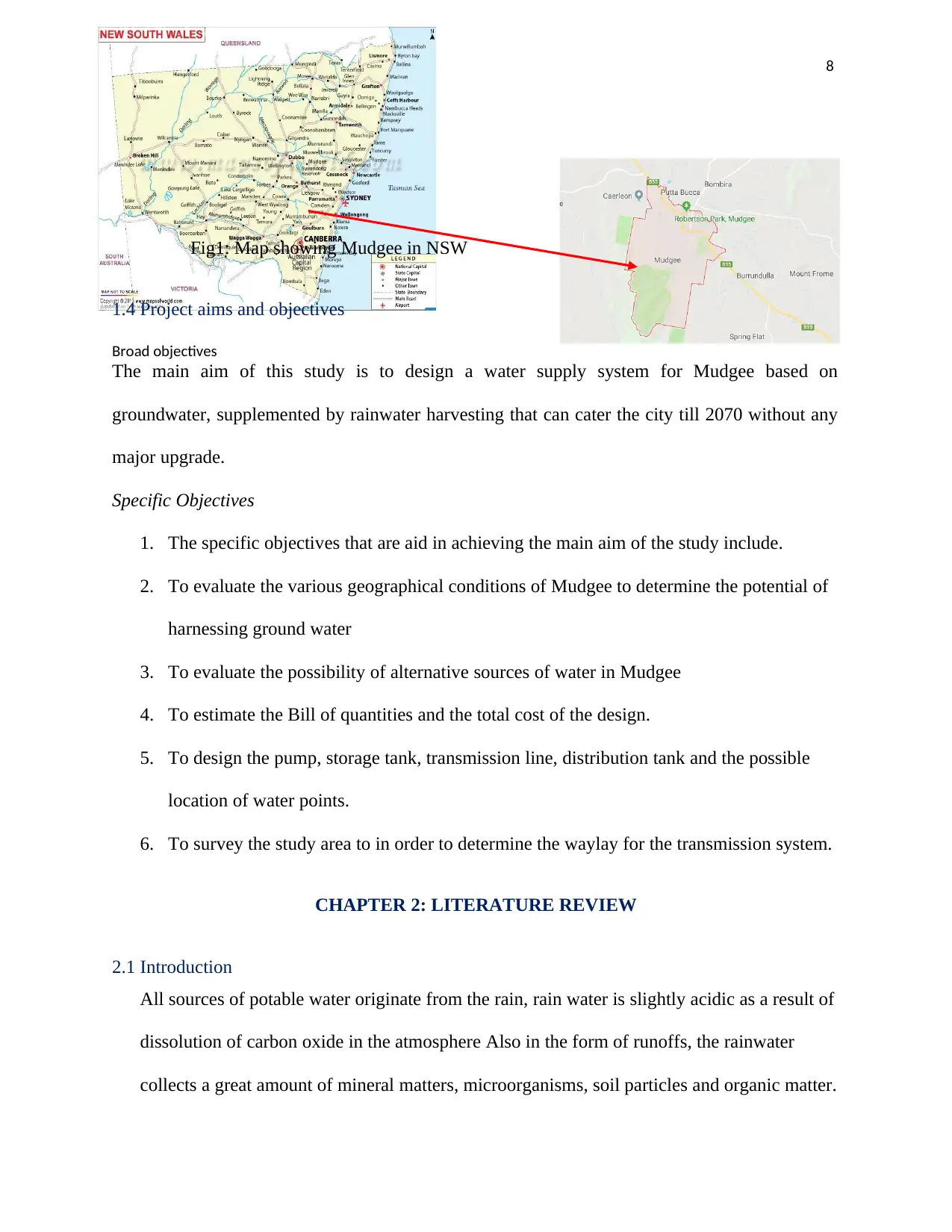
8
Fig1: Map showing Mudgee in NSW
1.4 Project aims and objectives
Broad objectives
The main aim of this study is to design a water supply system for Mudgee based on
groundwater, supplemented by rainwater harvesting that can cater the city till 2070 without any
major upgrade.
Specific Objectives
1. The specific objectives that are aid in achieving the main aim of the study include.
2. To evaluate the various geographical conditions of Mudgee to determine the potential of
harnessing ground water
3. To evaluate the possibility of alternative sources of water in Mudgee
4. To estimate the Bill of quantities and the total cost of the design.
5. To design the pump, storage tank, transmission line, distribution tank and the possible
location of water points.
6. To survey the study area to in order to determine the waylay for the transmission system.
CHAPTER 2: LITERATURE REVIEW
2.1 Introduction
All sources of potable water originate from the rain, rain water is slightly acidic as a result of
dissolution of carbon oxide in the atmosphere Also in the form of runoffs, the rainwater
collects a great amount of mineral matters, microorganisms, soil particles and organic matter.
Fig1: Map showing Mudgee in NSW
1.4 Project aims and objectives
Broad objectives
The main aim of this study is to design a water supply system for Mudgee based on
groundwater, supplemented by rainwater harvesting that can cater the city till 2070 without any
major upgrade.
Specific Objectives
1. The specific objectives that are aid in achieving the main aim of the study include.
2. To evaluate the various geographical conditions of Mudgee to determine the potential of
harnessing ground water
3. To evaluate the possibility of alternative sources of water in Mudgee
4. To estimate the Bill of quantities and the total cost of the design.
5. To design the pump, storage tank, transmission line, distribution tank and the possible
location of water points.
6. To survey the study area to in order to determine the waylay for the transmission system.
CHAPTER 2: LITERATURE REVIEW
2.1 Introduction
All sources of potable water originate from the rain, rain water is slightly acidic as a result of
dissolution of carbon oxide in the atmosphere Also in the form of runoffs, the rainwater
collects a great amount of mineral matters, microorganisms, soil particles and organic matter.
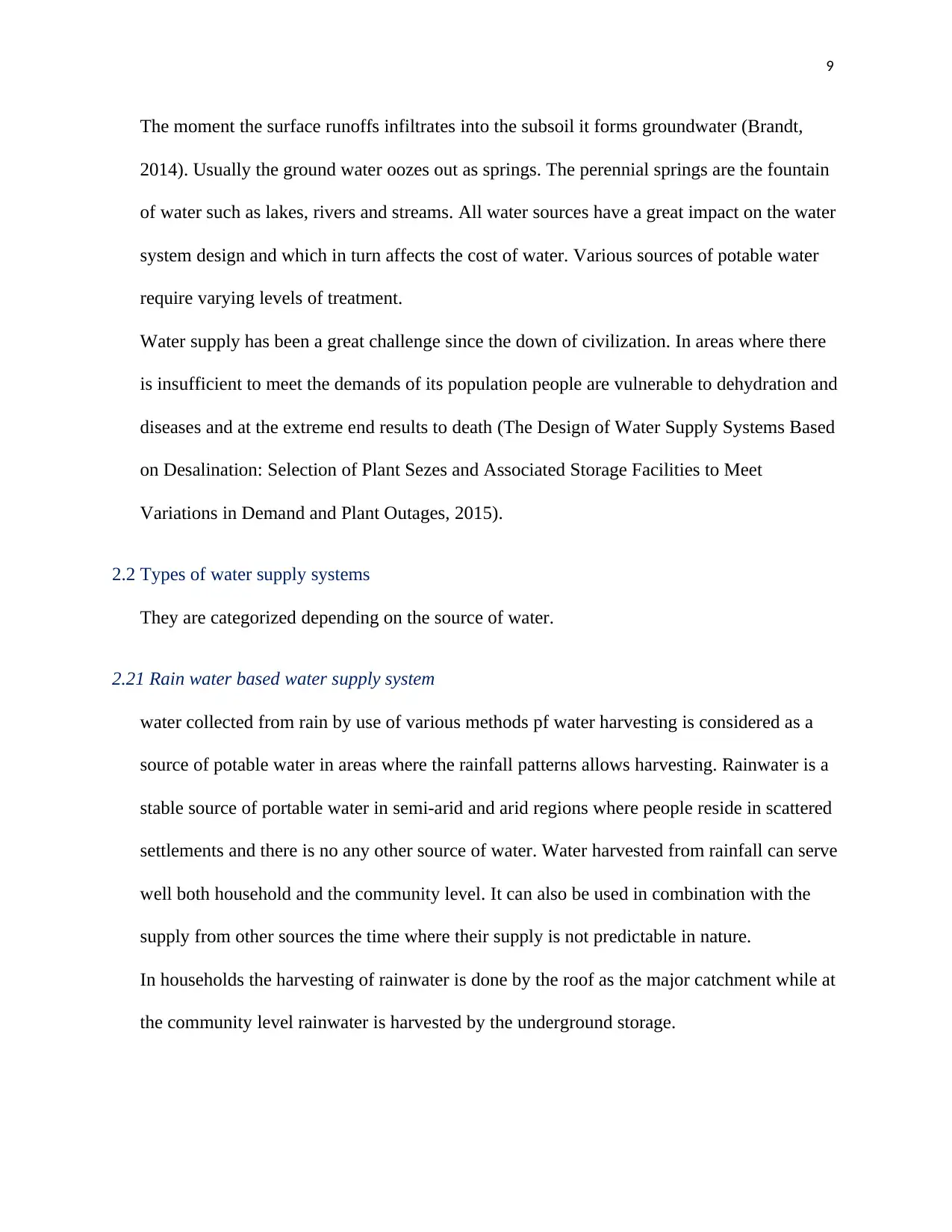
9
The moment the surface runoffs infiltrates into the subsoil it forms groundwater (Brandt,
2014). Usually the ground water oozes out as springs. The perennial springs are the fountain
of water such as lakes, rivers and streams. All water sources have a great impact on the water
system design and which in turn affects the cost of water. Various sources of potable water
require varying levels of treatment.
Water supply has been a great challenge since the down of civilization. In areas where there
is insufficient to meet the demands of its population people are vulnerable to dehydration and
diseases and at the extreme end results to death (The Design of Water Supply Systems Based
on Desalination: Selection of Plant Sezes and Associated Storage Facilities to Meet
Variations in Demand and Plant Outages, 2015).
2.2 Types of water supply systems
They are categorized depending on the source of water.
2.21 Rain water based water supply system
water collected from rain by use of various methods pf water harvesting is considered as a
source of potable water in areas where the rainfall patterns allows harvesting. Rainwater is a
stable source of portable water in semi-arid and arid regions where people reside in scattered
settlements and there is no any other source of water. Water harvested from rainfall can serve
well both household and the community level. It can also be used in combination with the
supply from other sources the time where their supply is not predictable in nature.
In households the harvesting of rainwater is done by the roof as the major catchment while at
the community level rainwater is harvested by the underground storage.
The moment the surface runoffs infiltrates into the subsoil it forms groundwater (Brandt,
2014). Usually the ground water oozes out as springs. The perennial springs are the fountain
of water such as lakes, rivers and streams. All water sources have a great impact on the water
system design and which in turn affects the cost of water. Various sources of potable water
require varying levels of treatment.
Water supply has been a great challenge since the down of civilization. In areas where there
is insufficient to meet the demands of its population people are vulnerable to dehydration and
diseases and at the extreme end results to death (The Design of Water Supply Systems Based
on Desalination: Selection of Plant Sezes and Associated Storage Facilities to Meet
Variations in Demand and Plant Outages, 2015).
2.2 Types of water supply systems
They are categorized depending on the source of water.
2.21 Rain water based water supply system
water collected from rain by use of various methods pf water harvesting is considered as a
source of potable water in areas where the rainfall patterns allows harvesting. Rainwater is a
stable source of portable water in semi-arid and arid regions where people reside in scattered
settlements and there is no any other source of water. Water harvested from rainfall can serve
well both household and the community level. It can also be used in combination with the
supply from other sources the time where their supply is not predictable in nature.
In households the harvesting of rainwater is done by the roof as the major catchment while at
the community level rainwater is harvested by the underground storage.
⊘ This is a preview!⊘
Do you want full access?
Subscribe today to unlock all pages.

Trusted by 1+ million students worldwide
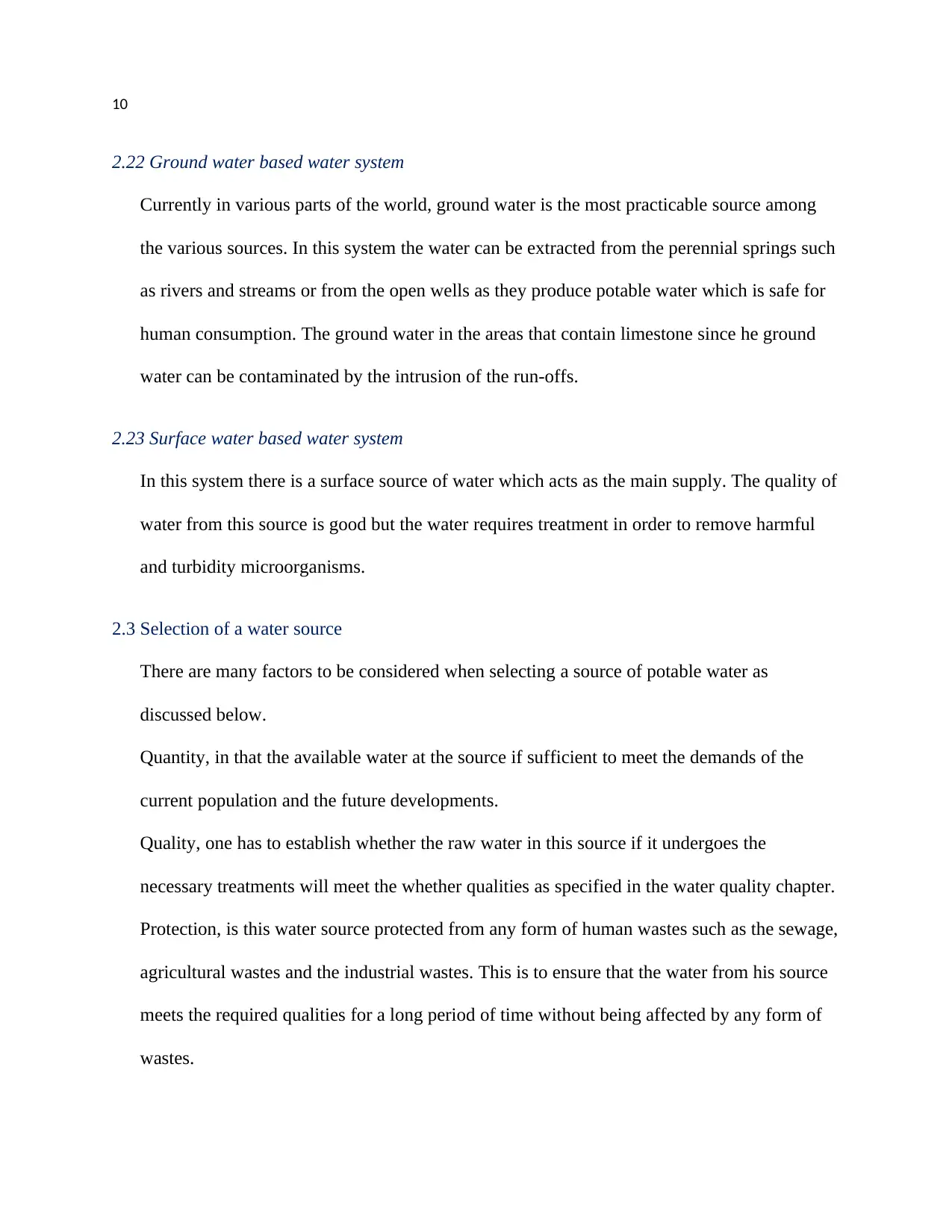
10
2.22 Ground water based water system
Currently in various parts of the world, ground water is the most practicable source among
the various sources. In this system the water can be extracted from the perennial springs such
as rivers and streams or from the open wells as they produce potable water which is safe for
human consumption. The ground water in the areas that contain limestone since he ground
water can be contaminated by the intrusion of the run-offs.
2.23 Surface water based water system
In this system there is a surface source of water which acts as the main supply. The quality of
water from this source is good but the water requires treatment in order to remove harmful
and turbidity microorganisms.
2.3 Selection of a water source
There are many factors to be considered when selecting a source of potable water as
discussed below.
Quantity, in that the available water at the source if sufficient to meet the demands of the
current population and the future developments.
Quality, one has to establish whether the raw water in this source if it undergoes the
necessary treatments will meet the whether qualities as specified in the water quality chapter.
Protection, is this water source protected from any form of human wastes such as the sewage,
agricultural wastes and the industrial wastes. This is to ensure that the water from his source
meets the required qualities for a long period of time without being affected by any form of
wastes.
2.22 Ground water based water system
Currently in various parts of the world, ground water is the most practicable source among
the various sources. In this system the water can be extracted from the perennial springs such
as rivers and streams or from the open wells as they produce potable water which is safe for
human consumption. The ground water in the areas that contain limestone since he ground
water can be contaminated by the intrusion of the run-offs.
2.23 Surface water based water system
In this system there is a surface source of water which acts as the main supply. The quality of
water from this source is good but the water requires treatment in order to remove harmful
and turbidity microorganisms.
2.3 Selection of a water source
There are many factors to be considered when selecting a source of potable water as
discussed below.
Quantity, in that the available water at the source if sufficient to meet the demands of the
current population and the future developments.
Quality, one has to establish whether the raw water in this source if it undergoes the
necessary treatments will meet the whether qualities as specified in the water quality chapter.
Protection, is this water source protected from any form of human wastes such as the sewage,
agricultural wastes and the industrial wastes. This is to ensure that the water from his source
meets the required qualities for a long period of time without being affected by any form of
wastes.
Paraphrase This Document
Need a fresh take? Get an instant paraphrase of this document with our AI Paraphraser
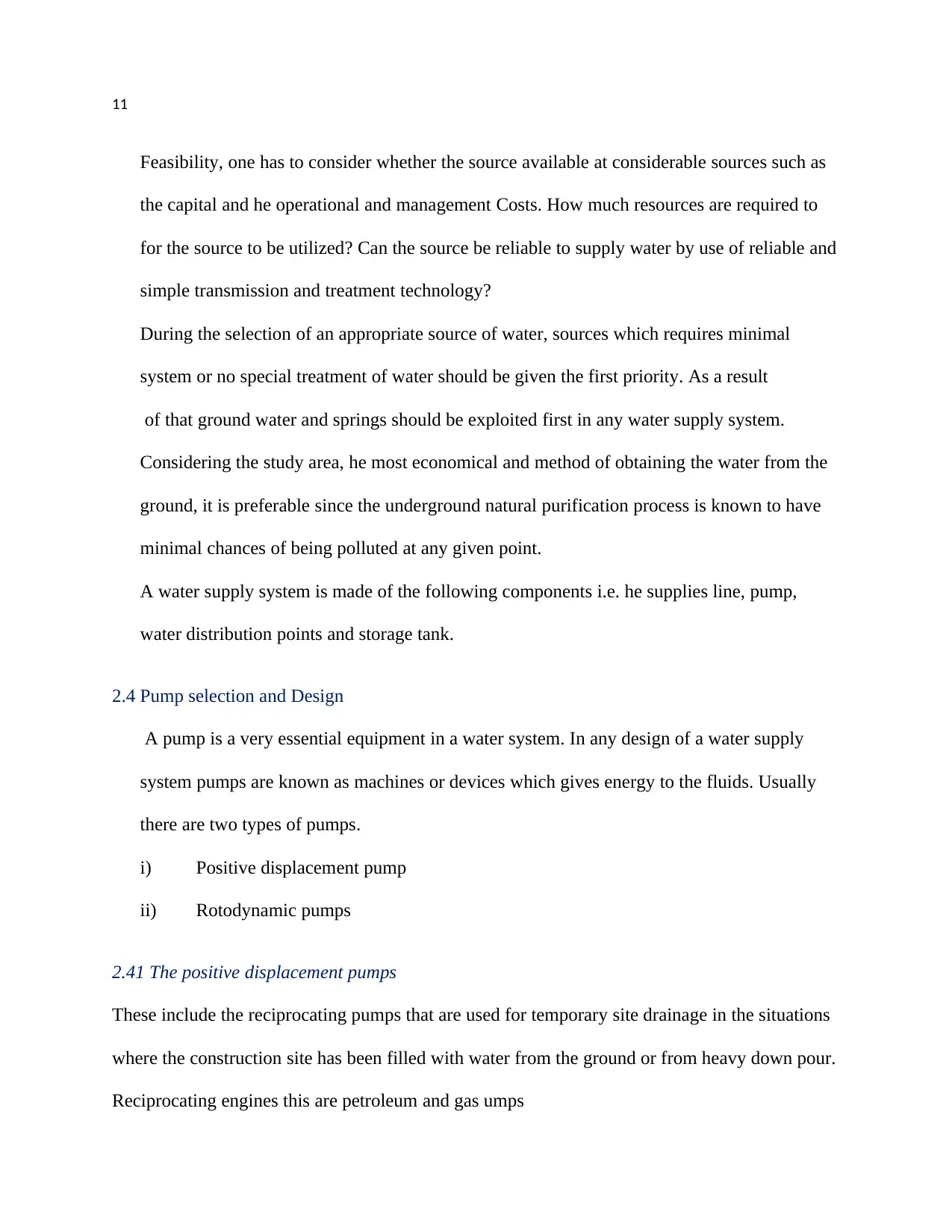
11
Feasibility, one has to consider whether the source available at considerable sources such as
the capital and he operational and management Costs. How much resources are required to
for the source to be utilized? Can the source be reliable to supply water by use of reliable and
simple transmission and treatment technology?
During the selection of an appropriate source of water, sources which requires minimal
system or no special treatment of water should be given the first priority. As a result
of that ground water and springs should be exploited first in any water supply system.
Considering the study area, he most economical and method of obtaining the water from the
ground, it is preferable since the underground natural purification process is known to have
minimal chances of being polluted at any given point.
A water supply system is made of the following components i.e. he supplies line, pump,
water distribution points and storage tank.
2.4 Pump selection and Design
A pump is a very essential equipment in a water system. In any design of a water supply
system pumps are known as machines or devices which gives energy to the fluids. Usually
there are two types of pumps.
i) Positive displacement pump
ii) Rotodynamic pumps
2.41 The positive displacement pumps
These include the reciprocating pumps that are used for temporary site drainage in the situations
where the construction site has been filled with water from the ground or from heavy down pour.
Reciprocating engines this are petroleum and gas umps
Feasibility, one has to consider whether the source available at considerable sources such as
the capital and he operational and management Costs. How much resources are required to
for the source to be utilized? Can the source be reliable to supply water by use of reliable and
simple transmission and treatment technology?
During the selection of an appropriate source of water, sources which requires minimal
system or no special treatment of water should be given the first priority. As a result
of that ground water and springs should be exploited first in any water supply system.
Considering the study area, he most economical and method of obtaining the water from the
ground, it is preferable since the underground natural purification process is known to have
minimal chances of being polluted at any given point.
A water supply system is made of the following components i.e. he supplies line, pump,
water distribution points and storage tank.
2.4 Pump selection and Design
A pump is a very essential equipment in a water system. In any design of a water supply
system pumps are known as machines or devices which gives energy to the fluids. Usually
there are two types of pumps.
i) Positive displacement pump
ii) Rotodynamic pumps
2.41 The positive displacement pumps
These include the reciprocating pumps that are used for temporary site drainage in the situations
where the construction site has been filled with water from the ground or from heavy down pour.
Reciprocating engines this are petroleum and gas umps
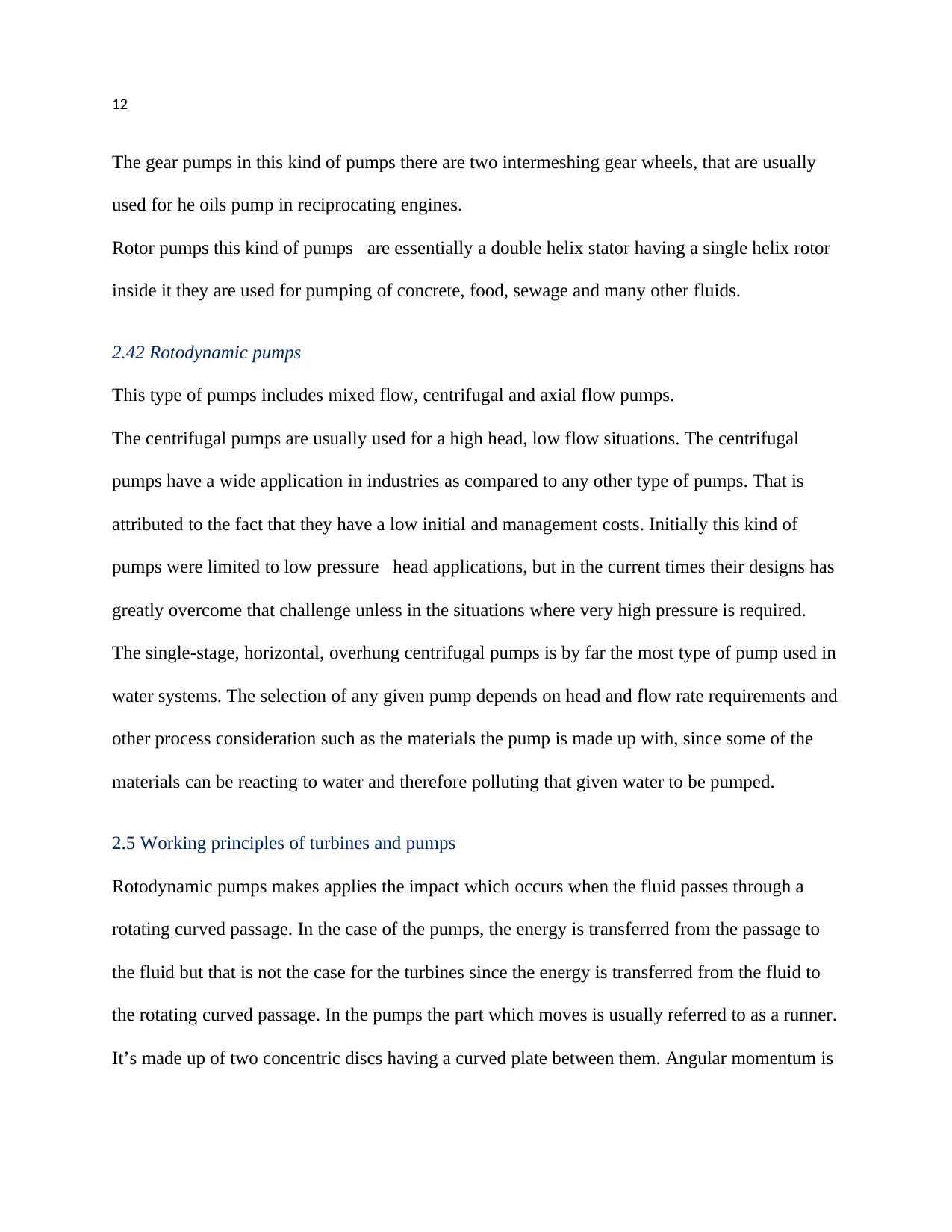
12
The gear pumps in this kind of pumps there are two intermeshing gear wheels, that are usually
used for he oils pump in reciprocating engines.
Rotor pumps this kind of pumps are essentially a double helix stator having a single helix rotor
inside it they are used for pumping of concrete, food, sewage and many other fluids.
2.42 Rotodynamic pumps
This type of pumps includes mixed flow, centrifugal and axial flow pumps.
The centrifugal pumps are usually used for a high head, low flow situations. The centrifugal
pumps have a wide application in industries as compared to any other type of pumps. That is
attributed to the fact that they have a low initial and management costs. Initially this kind of
pumps were limited to low pressure head applications, but in the current times their designs has
greatly overcome that challenge unless in the situations where very high pressure is required.
The single-stage, horizontal, overhung centrifugal pumps is by far the most type of pump used in
water systems. The selection of any given pump depends on head and flow rate requirements and
other process consideration such as the materials the pump is made up with, since some of the
materials can be reacting to water and therefore polluting that given water to be pumped.
2.5 Working principles of turbines and pumps
Rotodynamic pumps makes applies the impact which occurs when the fluid passes through a
rotating curved passage. In the case of the pumps, the energy is transferred from the passage to
the fluid but that is not the case for the turbines since the energy is transferred from the fluid to
the rotating curved passage. In the pumps the part which moves is usually referred to as a runner.
It’s made up of two concentric discs having a curved plate between them. Angular momentum is
The gear pumps in this kind of pumps there are two intermeshing gear wheels, that are usually
used for he oils pump in reciprocating engines.
Rotor pumps this kind of pumps are essentially a double helix stator having a single helix rotor
inside it they are used for pumping of concrete, food, sewage and many other fluids.
2.42 Rotodynamic pumps
This type of pumps includes mixed flow, centrifugal and axial flow pumps.
The centrifugal pumps are usually used for a high head, low flow situations. The centrifugal
pumps have a wide application in industries as compared to any other type of pumps. That is
attributed to the fact that they have a low initial and management costs. Initially this kind of
pumps were limited to low pressure head applications, but in the current times their designs has
greatly overcome that challenge unless in the situations where very high pressure is required.
The single-stage, horizontal, overhung centrifugal pumps is by far the most type of pump used in
water systems. The selection of any given pump depends on head and flow rate requirements and
other process consideration such as the materials the pump is made up with, since some of the
materials can be reacting to water and therefore polluting that given water to be pumped.
2.5 Working principles of turbines and pumps
Rotodynamic pumps makes applies the impact which occurs when the fluid passes through a
rotating curved passage. In the case of the pumps, the energy is transferred from the passage to
the fluid but that is not the case for the turbines since the energy is transferred from the fluid to
the rotating curved passage. In the pumps the part which moves is usually referred to as a runner.
It’s made up of two concentric discs having a curved plate between them. Angular momentum is
⊘ This is a preview!⊘
Do you want full access?
Subscribe today to unlock all pages.

Trusted by 1+ million students worldwide
1 out of 27
Related Documents
Your All-in-One AI-Powered Toolkit for Academic Success.
+13062052269
info@desklib.com
Available 24*7 on WhatsApp / Email
![[object Object]](/_next/static/media/star-bottom.7253800d.svg)
Unlock your academic potential
Copyright © 2020–2025 A2Z Services. All Rights Reserved. Developed and managed by ZUCOL.




